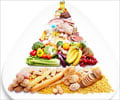A diet rich in processed carbohydrates, which are also high glycemic index (GI) foods, such as cakes, pastries, macaroni and cheese, alone or coupled with a sedentary lifestyle, promotes insulin resistance and is one of the quickest way to get the bulge. This is well known. Insulin resistance causes blood sugar and insulin levels to stay high long after eating. And that’s not all. High blood pressure, high levels of triglycerides, and low HDL (good) cholesterol are all linked to insulin resistance and increase the risk for diabetes, heart disease and obesity.
We also know from experience that at times we crave for these high GI foods; it sort of becomes addictive. There are three things to note here:• Foods high in glycemic index are digested very quickly and in no time you are hungry again.
• Since high GI foods are deficient in fiber, you just end up with lot of empty calories.
• High GI foods make you feel good; they make you feel content.
Know that pleasant feeling and wanting to reach out for more of those goodies? That craving is caused by dopamine, a neurotransmitter in the brain that is released in response to pleasure and rewarding activities. Just like some drugs and sex – high GI foods that make you feel good increase the dopamine activity.
But how?
‘Beyond reward and craving, this part of the brain is also linked to substance abuse and dependence, which raises the question as to whether certain foods might be addictive,’ says Ludwig.
Researchers measured blood glucose levels and hunger, and observed brain activity during the four-hour period after a meal using functional magnetic resonance imaging (fMRI). The four-hour period after eating is important because this is the time frame which drives our eating behavior at the next meal.
After drinking the high-glycemic index milkshake, the participants experienced an initial surge in the blood sugar levels, followed by sharp crash four hours later. This decrease in blood glucose was associated with excessive hunger and greater brain activity centered in the right nucleus accumbens, a critical brain region involved in addictive behaviors.
‘These findings suggest that limiting high-glycemic index carbohydrates like white bread and potatoes could help obese individuals reduce cravings and control the urge to overeat,’ says Ludwig.
Although the findings are not different than those found in other such studies, there were two new aspects to the study-
• The researchers in this study evaluated patients with an fMRI in the four-hour after a meal time frame, whereas previous studies have evaluated patients with an MRI soon after eating.
• This study compared high glycemic index carbs to low glycemic index carbs as against high-calorie to low-calorie meals comparison made by previous studies. They showed how high GI foods could alter brain function and promote overeating.
‘Compared with an isocaloric low-GI meal, a high-GI meal decreased plasma glucose, increased hunger, and selectively stimulated brain regions associated with reward and craving in the late postprandial period,’ concluded the researchers.
Source-Medindia















